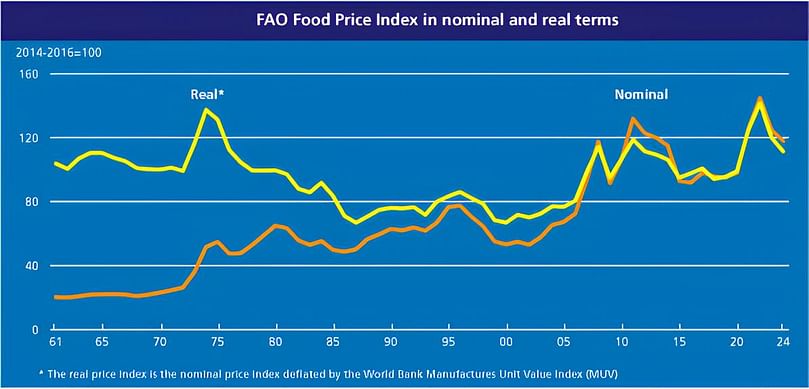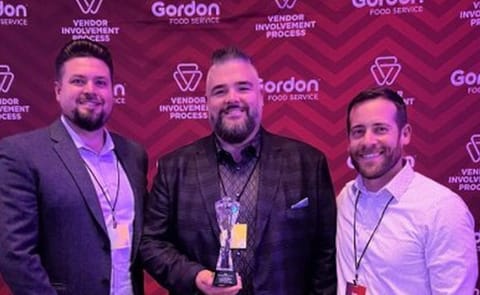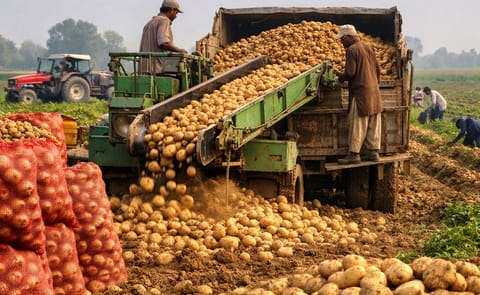FAO Food Price fell further in January mainly on lower wheat and maize prices
Primaire tabs
FAO Food Price fell further in January mainly on lower wheat and maize prices

The FAO Food Price Index*(FFPI) stood at 118.0 points in January 2024, down 1.2 points (1.0 percent) from its revised December level, as decreases in the price indices for cereals and meat more than offset an increase in the sugar price index, while those for dairy and vegetable oils only registered slight adjustments.
The index stood 13.7 points (10.4 percent) below its corresponding value one year ago.
The FAO Cereal Price Index averaged 120.1 points in January, down 2.7 points (2.2 percent) from December and as much as 27.4 points (18.6 percent) from its January 2023 value.
Global wheat export prices declined in January, driven by continued strong competition among exporters and arrival of recently harvested supplies in the southern hemisphere countries.
Maize export prices fell sharply month-on-month, reflecting improved crop conditions and the start of the harvest in Argentina as well as larger supplies in the United States of America following an upward revision of its production estimates.
In tandem with wheat and maize prices, world prices of barley and sorghum also decreased in January. By contrast, the FAO All Rice Price Index increased by a further 1.2 percent in January, largely reflecting a rise in prices of higher quality Indica rice due to a strong pace of Thai and Pakistani shipments and additional purchases by Indonesia.
The FAO Vegetable Oil Price Index averaged 122.5 points in January, up marginally by 0.2 points (0.1 percent) from the previous month, but still 17.9 points (12.8 percent) below its January 2023 reading.
The steadiness in the price index month-on-month reflected the combined effects of higher global palm and sunflower seed oil prices offsetting lower soy and rapeseed oil quotations.
International palm oil prices increased moderately in January, primarily underpinned by seasonally lower production in major producing countries and concerns over unfavourable weather conditions in Malaysia.
Meanwhile, world sunflower seed oil quotations edged up, driven by increased import demand, particularly from Türkiye. By contrast, international soy and rapeseed oil prices declined on account of, respectively, prospects for large supplies from South America and lingering ample availabilities in Europe.
The FAO Dairy Price Index averaged 118.9 points in January, virtually unchanged from its revised December value and standing 25.8 points (17.8 percent) below its value in the corresponding month a year ago.
In January, international price quotations for butter and whole milk powder (WMP) increased, nearly offsetting declines in those for skim milk powder (SMP) and cheese.
World butter prices rose due to increased demand from Asian buyers, coupled with more robust demand from the retail sector for replenishing stocks and lighter inventories in Western Europe.
Meanwhile, WMP prices also increased, reflecting increased demand for medium-term deliveries, especially by China, and seasonally falling production in New Zealand.
By contrast, international prices of SMP and cheese declined as demand for spot supplies remained muted and immediate requirements of buyers were adequately covered.
The FAO Meat Price Index* averaged 109.8 points in January, down 1.5 points (1.4 percent) from December, marking the seventh consecutive monthly decline and standing 1.3 points (1.2 percent) below its corresponding value last year.
International price quotations for poultry meat fell further in January, underpinned by persistent subdued global demand and ample exportable availabilities in leading exporting countries.
Similarly, pig meat quotations declined slightly due to a drop in import purchases by China in line with rising national pig meat production and abundant supplies from some producing countries. World bovine meat prices also fell marginally, primarily reflecting high export supplies from Oceania and South America.
By contrast, international ovine meat prices increased on high global import demand and lower supplies of animals for slaughter in Oceania as recent rains have incentivised farmers to retain animals longer.
The FAO Sugar Price Index averaged 135.3 points in January, up 1.1 points (0.8 percent) from December and 18.5 points (15.9 percent) from its value a year ago.
The increase in world sugar prices was mainly driven by concerns over the likely impact of below-average rains in Brazil on sugarcane crops to be harvested from April, coupled with the slow start of the new season and unfavourable production prospects in Thailand and India, two major producing countries.
However, large supplies from the recently completed harvest and lower returns from ethanol sales in Brazil, together with the weakening of the Brazilian real against the United States dollar, contributed to limiting the month-on-month increase in world sugar prices.

FAO Food Price Index in nominal and real terms










